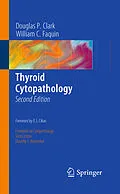Thyroid Cytopathology, Second Edition, in the Essentials in Cytopathology Series, provides an overview to the examination and diagnosis of thyroid cytology specimens. Each concise desktop reference in the Essentials in Cytopathology Series is designed as an easy-to-use and authoritative synopsis of site-specific topics in cytopathology.
Thyroid Cytopathology uses a simple algorithmic approach to the diagnosis of thyroid fine needle aspirations (FNA). This user-friendly, reference begins with an introduction to clinical aspects, a guide to performing and processing thyroid FNAs, and an overview to the algorithmic approach to thyroid FNA cytopathology. Organized in 11 easy-to-read chapters, this volume discusses the background, diagnostic approaches and criteria, differential diagnoses, and clinical management of inflammatory, colloid, follicular, Hurthle cell and cystic lesions, as well as, papillary, medullary and undifferentiated carcinomas.
With 116 full-color images, 12 tables and a series of algorithms, Thyroid Cytopathology is the ideal quick reference guide covering the essentials of thyroid FNA. It is a must-have for every pathologist, cytopathologist, cytotechnologist, fellow and trainee.
Zusammenfassung
The evaluation of thyroid nodules by fine needle aspiration (FNA) is one of the most challenging tasks in all of cytopathology. A cytologist must understand the clinical presentation of thyroid diseases, their defining histopathologic and cytopathologic features, and even the intricacies of patient management. Drs. Clark and Faquin have provided a valuable framework for cytologists learning (and continuing to learn) this exacting discipline. Org- ized around a practical algorithm, the authors lay out a rational and concise approach toward acquiring the necessary skills for the cytologic diagnosis of thyroid nodules. The first edition, published in 2005, was a very welcome addition to the cytology literature. This new edition, with updated terminology for reporting thyroid FNA results, builds on the success of their approach. Why are we examining such challenging specimens? Clearly, the clinical need is there. Over 50% of adults have one or more thyroid nodules. Surgical excision of all nodules is certainly neither practical nor desirable. Enter FNA, a minimally invasive cellular sampling method that has proven to be a highly useful screening test for thyroid cancer. Because of it, thousands of patients with a benign diagnosis are spared unnecessary surgery every year, and those with cancer are reliably triaged for appropriate therapy.
Inhalt
and Clinical Aspects.- How to Perform and Process a Thyroid FNA.- Approach to Thyroid FNA Cytopathology: An Overview.- Inflammatory Lesions and Lymphoma.- Colloid-Predominant Lesions.- Follicular Lesions.- Hurthle Cell Lesions.- Cystic Lesions of the Thyroid.- Papillary Thyroid Carcinoma.- Medullary Thyroid Carcinoma.- Undifferentiated (Anaplastic) Carcinoma and Secondary Tumors.
